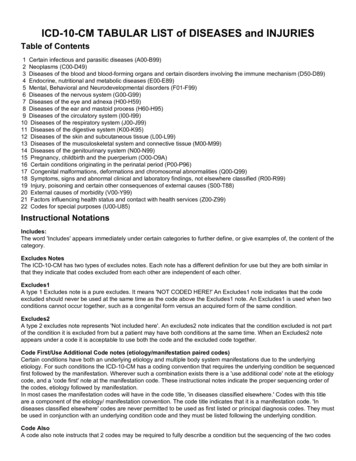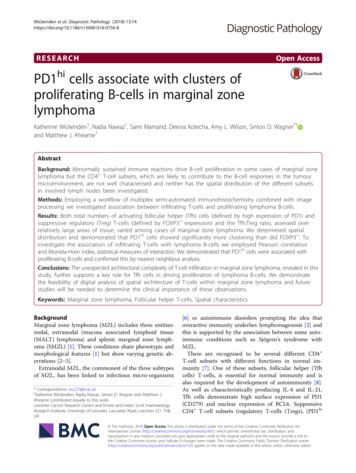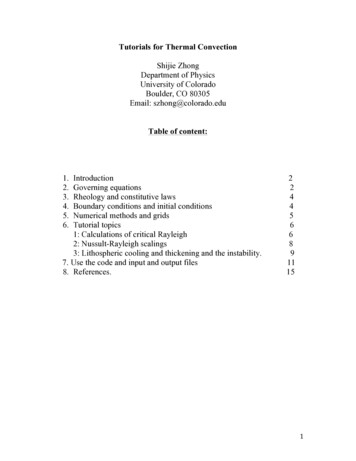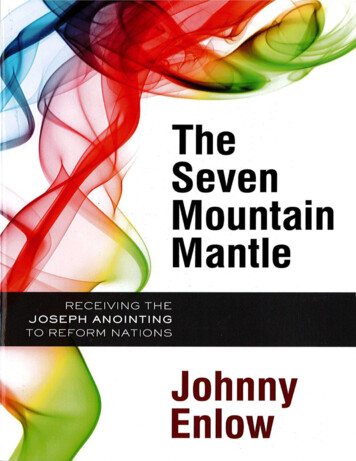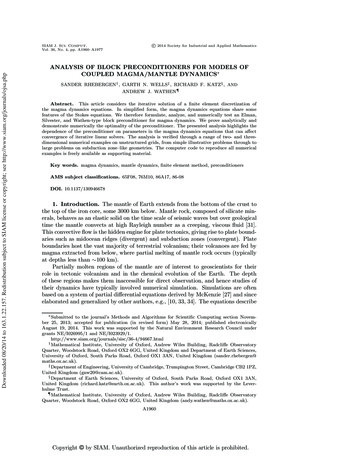
Transcription
Mantle Cell Lymphoma: Etiology,Manifestation, Prevalence, Treatment,& Survival of a Rare Non-HodgkinLymphomaC A R I S S A O R I G E R , PA - S 2U N I V E R S I T Y O F S O U T H D A K O TA
Objectives01020304Identify characteristicsand manifestations ofMantle cell lymphoma(MCL).Identify theetiology/pathogenesis ofMCL.Discuss the prevalenceand overall survival ofMCL.Discuss treatment andremission of MCL.
Case Study**Disclaimer: consent from patient to share caseDate: 6-14-19CC: “sinus problem”HPI: Patient is a 47 yo male with a history of chronic nasal congestion. He states nothing he has tried seems to clear his symptoms. Iactually saw him back in February when he was complaining of nasal congestion and sinus drainage. He had sinus pressure as well. Hehad been on antibiotics and steroids and seemed to improve, but his symptoms had worsened. He indicates his sense of smell wasdiminished, but he was also complaining of eustachian tube dysfunction and that his ears became plugged and full. Following thatencounter, we placed him on a prednisone taper, some Mucinex, and continued on the Flonase and Allegra and got a CT of thesinuses. CT really did not show anything significant. There was minimal evidence of disease and I had recommended that he stay onthe allergy medicine. He subsequently saw an allergist and was tested and found no significant positives. He is back today because heis frustrated by the nasal congestion that he seems to have chronically. It is worse when he lies down at night. Currently, he is onAstelin and Flonase and his symptoms have not improved. He has had no nosebleeds. Does not describe any other sinus issues. Hedoes display nasal speech today.Additional s/s not listed: Unintentional weight loss of almost 20 pounds, new onset snoring, increased fatigue, dysphagia
Physical Exam/Flexed Scope Evaluation Nose/Nasopharynx: External nose: Normal size and appearance; no tenderness; no discharge; nostrils patent; no evidence of trauma Intranasal exam: Nasal mucosa pink and moist, inferior turbinate normal; middle and superior turbinate normal; septummidline The nose was prepped and the flexible scope was used to evaluate primarily the nasal cavity and nasopharynx. There does appearto be some type of growth in the posterior nasopharynx occluding the nasal choana. It is difficult to tell whether this is posterior nasalcavity tissue or nasopharyngeal tissue or adenoid regrowth.Assessment: Nasopharyngeal massPlan: I had Dr. *** look at it as well. We both agree that there is some suspicious tissue in the back of the nose or in the nasopharynx. This needsto be biopsied. The CT we obtained back in February did not have contrast, but at this point we are going to set him up for direct visualization andbiopsy and possible removal of the tissue, by Dr. ***, under general anesthesia.
d 2415
Why Mantle CellLymphoma?
LymphomaHodgkin & non-Hodgkin lymphoma Hodgkin lymphoma – Reed Sternberg cells Non-Hodgkin lymphoma (NHL) – absence of Reed Sternbergcells 60 types of NHLs (Han et. al, 2017) B cell (85-90% of NHLs) T/NK cellAggressive B-cell NHLs – including Mantle Cell lymphoma(MCL).https://www.google.com/url?sa i&url EpxZk&psig AOvVaw3weLWpOoxzEqibgYlqjAbU&ust 1589224013973000&source images&cd vfe&ved 0CAIQjRxqFwoTCOi0tZb qekCFQAAAAAdAAAAABAD
Mantle Cell LymphomaOther names: intermediate lymphocytic lymphoma,mantle zone lymphoma, centrocytic lymphoma, andlymphocytic lymphoma of intermediatedifferentiation2-7% of NHLs (Rule, 2019)Mantle zone of the follicleS/S: Unexplained weight lossFeverNight sweatsLymphadenopathyFatigueAsymptomatic in early 45/secondary-lymphoid-tissue
MCLAdvanced disease1st presentation – usually lymphadenopathy (75%)Extranodal disease – (25%)Common sites: lymph nodes, spleen, waldeyer’s ring, bonemarrow, blood, and extranodal sites (GI, breast, pleura,orbit)CNS involvement is rareUp-to-date (2021).
Etiology/PathogenesisReciprocal translocation of t(11;14) Overexpression of cyclin D1 gene Present in approximately 85%Cellular origins: Classical MCL or “leukemic”variant of MCLCortelazzo & colleagues – genetic predisposition of having 1st degree relative with MCL or NHL (2012).Pesticides, Fungicides, & Herbicides: Alavanja & colleagues – 10 years of exposure led to risk of developing NHL (2014). Hoffman et al. – growing up on a farm increased risk (2015). Kisby – exposure shows oxidative stress, DNA damage, immunosuppression, and neurological disease (2009).
Clinical EvaluationComplete H&PBloodwork (CBCD, CMP, HIV, Serum Immunoglobulins, SPEP, genetic testing, etc. ) LDH & beta2 microglobulinCT/PET scanColonoscopyBone Marrow biopsyTissue biopsyCardiac workup – EKG, Echo, MUGA
odgkin-lymphoma/diagnosis/nhl-staging
PrognosisCopyrights apply
Copyrights apply
Mantle CellInternationalPrognosticIndex (MIPI)Low, intermediate, or high riskECOG – Eastern CooperativeOncology nternational-prognostic-index-mipi#next-steps
Prevalence M F – approx. ¾ of patients are males Median Age: 68 years old Incidence non-Hispanic whites Hispanics, Asian/Pacific Islanders, NH Black (Jain & Wang, 2019). Multivariant Study (Shah, 2019) – Assessed racial and socioeconomic disparities
Inferior OS NH Black Without insurance Community treatment centers Greatest OS in Hispanic
Patient ase StagePrimary or recurrent MCLEF?
Young, Healthy6 Cycles alternating:Rituximab CHOP Cyclophosphamide, hydroxydaunomycin, onvcovin(Vincristine), and prednisoloneRituximab R-DHAP Dexamethasone, cytarabine, and cisplatinORNordic Regimen (6 cycles alternating):Rituximab high-dose cytarabineRituximab Maxi-CHOP Cyclophosphamide, hydroxydaunomycin(Doxorubicin), onvcovin (Vincristine), andprednisone
Autologous Stem Cell TransplantSelf at about allogenic transplants?
Allogeneic Stem Cell Transplant Graft -versus-host disease (GVHD)Advantages (Tam & Khouri, 2009): Graft vs. lymphoma (GVL) – prevent chemoresistanceLimitation:30% transplant-related mortality
High Risk Patients &IndolentHigh-risk patients:Not eligible for high dose intensive chemotherapyImmunochemotherapy: bendamustine-based regimen Rituximab maintenance therapyIndolent or Low risk:Watch & wait
Remission2015 – 584,000 individuals living with history of NHL Estimation 710,000 by 2022 (Spector et al., 2015)Long-term effects: Persistent pain Depression Post-traumatic stress disorder Fatigue Cardiac toxicities Risk of secondary malignancies
Refractory/Relapse of MCLAveraged 5-7 years OSGerson & Colleagues (2019): OS: 139 months High-risk MCL: 37 monthsIncurable with relapse in months - years More aggressive Treatment resistant Relapse commonly occurs in GI (Ahmed et al., 2018)
ResearchCell cycle inhibitors – type ofdrug would be utilized toprevent cell proliferationProteasome inhibitors – blockcellular pathways preventingcell growth and survivalinhibiting the proteinsnecessary for these actions tooccurMonoclonal antibodies –block growth of cancer cellsby attacking cells butminimize harm to normalcellsImmunomodulators – modifymultiplication and growth ofcells of the immune systemTyrosine kinase inhibitors –block signals of proliferationof cellsmTOR inhibitors – reducecyclin D1 expression to slowand inhibit MCL
Ahmed, R., Kumar, K., Makker, J., Niazi, M., & Balar, B. (2018). Recurrent Mantle CellLymphoma Presenting as Gastrointestinal Bleeding. Case Reports in Gastroenterology, 12(2), 379-384.Alavanja, M. C., Hofmann, J. N., Lynch, C. F., Hines, C. J., Barry, K. H., Barker, J., Beane Freeman, L. E. (2014). Non-hodgkin lymphoma risk and insecticide, fungicide and fumigant use in the agricultural health study. PloS one, 9(10), e109332.doi:10.1371/journal.pone.0109332American Cancer Society. (2019). Non-Hodgkin Lymphoma. Retrieved homa.htmlAmbinder, A., Shenoy, P., Nastoupil, L., & Flowers, C. (2013). Using primary site as a predictorof survival in mantle cell lymphoma. Cancer, 119(8), 1570-1577.Chiu, B. C., & Blair, A. (2009). Pesticides, chromosomal aberrations, and non-hodgkin'slymphoma. Journal of Agromedicine, 14(2), 250-255. doi:10.1080/10599240902773140Cortelazzo, Ponzoni, Ferreri, & Dreyling. (2012). Mantle cell lymphoma. Critical Reviews inOncology / Hematology, 82(1), 78-101.Edwin, & Kahl. (2018). Evolving treatment strategies in mantle cell lymphoma. Best Practice &Research Clinical Haematology, 31(3), 270-278.Falcone, U., & Kuruvilla, J. (2017). Autologous hematopoietic cell transplantation of mantle celllymphoma: Emerging trends. Current Opinion in Hematology, 24(6), 502-508.Gerson, J. N., Handorf, E., Villa, D., Gerrie, A. S., Chapani, P., Li, S., . . . Maddocks, K. J. (2019). Survival outcomes of younger patients with mantle cell lymphoma treated in the rituximab era.Journal of Clinical Oncology, 37(6), 471-480. doi:10.1200/JCO.18.00690ResourcesGopal, A., & Graf, S. (2017). Targeted Drugs as Maintenance Therapy after Autologous StemCell Transplantation in Patients with Mantle Cell Lymphoma. Pharmaceuticals, 10(1), 28.Han, A. Y., Kuan, E. C., Alonso, J. E., Badran, K. W., & St John, M. A. (2017). Epidemiology of nasopharyngeal lymphoma in the united states: a population-based analysis of 1119 cases.Otolaryngology Head Neck Surgery, 156(5), 870-876. doi:10.1177/0194599817695808Hofmann, J. N., Hoppin, J. A., Lynch, C. F., Poole, J. A., Purdue, M. P., Blair, A., Beane Freeman, L. E. (2015). Farm characteristics, allergy symptoms, and risk of non-hodgkin lymphoid neoplasms in the agricultural health study. Cancer epidemiology,biomarkers & prevention, 24(3), 587–594. doi:10.1158/1055-9965.EPI-14-1246Jain, P., & Wang, M. (2019). Mantle cell lymphoma: 2019 update on the diagnosis, pathogenesis, prognostication, and management. American Journal of Hematology, 94(6), 710-725.doi:10.1002/ajh.25487Kent, E., Breen, E., Lewis, N., Moor, D., Smith, R., & Seibel, J. (2015). US trends in survivaldisparities among adolescents and young adults with non-Hodgkin lymphoma. Cancer Causes & Control, 26(8), 1153-1162.Kisby GE, Muniz JF, Scherer J, Lasarev MR, Koshy M, Kow YW, & McCauley L. (2009). Oxidative stress and DNA damage in agricultural workers. Journal of Agromedicine, 14(2), 10599240902824042Leukemia and Lymphoma Society (LLS). (2015, February 26). NHL Subtypes. Retrieved oma/diagnosis/nhl-subtypes.Lymphoma Research Foundation (LRF). (2019). Non-Hodgkin Lymphoma. Retrieved from https://lymphoma.org/aboutlymphoma/nhl/National Organization for Rare Disorders (NORE). (2005). Mantle cell lymphoma. Retrieved from ases/mantle-cell-lymphoma/National Cancer Institute (NCI). (n.d.). Dictionary of Cancer Terms – Reed Sternberg Cell.Retrieved from ancer-terms/def/reed-sternberg-cell.Rule, S. (2019). The modern approach to mantle cell lymphoma. Hematological Oncology, 37 (1), 66-69. doi:10.1002/hon.2596Rule, S. (2017). Mantle Cell Lymphoma. Clinical Lymphoma Myeloma and Leukemia, 17,S174-S175.Shah, N. N., Xi, Y., Liu, Y., Koff, J. L., Flowers, C. R., Behera, M., & Cohen, J. B.(2019). Racial and socioeconomic disparities in mantle cell lymphoma. Clinical Lymphoma, Myeloma & Leukemia, 19(6), e312–e320. .03.006Spector, D., Noonan, D., Mayer, D., Benecha, H., Zimmerman, S., & Smith, S. (2015). Arelifestyle behavioral factors associated with health‐related quality of life in long‐term survivors of non‐Hodgkin lymphoma? Cancer, 121(18), 3343-3351.Tam, C., & Khouri, I. (2009). Autologous and allogeneic stem cell transplantation: Risingtherapeutic promise for mantle cell lymphoma. Leukemia & Lymphoma, 50(8), 1239-1248.Vogt, N., Dai, B., Erdmann, T., Berdel, W., & Lenz, G. (2017). The molecular pathogenesis ofmantle cell lymphoma. Leukemia & Lymphoma, 58(7), 1530-1537.Vose, J. M. (2012). Autotransplantation for Mantle Cell Lymphoma. The Cancer Journal, 18(5),427-431.Yuan, J., Li, S., Liu, X., Su, R. J., Chen, M., Wu, X., . . . Pan, Z. (2019). Mantle cell lymphoma with mantle zone growth pattern. American Journal of Clinical Pathology,152(2), 132-145. doi:10.1093/ajcp/aqz043Up-to-date
the allergy medicine. He subsequently saw an allergist and was tested and found no significant positives. He is back today be cause he is frustrated by the nasal congestion that he seems to have chronically. It is worse when he lies down at night. Currently, he is on Astelin and Flonase and his symptoms have not improved. He has had no nosebleeds.

